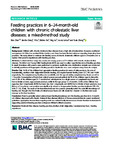Feeding practices in 6–24-month-old children with chronic cholestatic liver diseases: a mixed-method study
| dc.contributor.author | Chen, X | |
| dc.contributor.author | Wang, J | |
| dc.contributor.author | Lu, Y | |
| dc.contributor.author | Xie, X | |
| dc.contributor.author | Gu, Y | |
| dc.contributor.author | Latour, Jos M | |
| dc.contributor.author | Zhang, Y | |
| dc.date.accessioned | 2020-08-29T19:44:06Z | |
| dc.date.issued | 2020-08-24 | |
| dc.identifier.issn | 1471-2431 | |
| dc.identifier.issn | 1471-2431 | |
| dc.identifier.other | 395 | |
| dc.identifier.uri | http://hdl.handle.net/10026.1/16205 | |
| dc.description.abstract |
<jats:title>Abstract</jats:title><jats:sec><jats:title>Background</jats:title><jats:p>Children with chronic cholestatic liver diseases have a high risk of malnutrition. However, nutritional management in China has received little attention, and there has been limited evidence regarding improving these practices. This study aimed to evaluate the feeding status of chronic cholestatic children aged 6–24 months and to explore their parents’ experiences with feeding practices.</jats:p></jats:sec><jats:sec><jats:title>Methods</jats:title><jats:p>A mixed-method study was conducted among parents of 74 children with chronic cholestatic liver diseases. The Infant and Young Child Feeding Index (ICFI) was used to collect quantitative data of feeding practices. In-depth interviews with parents were performed to generate qualitative data. Multivariate analysis was conducted to identify predictors of inappropriate feeding practices. Qualitative data were analyzed using thematic analysis.</jats:p></jats:sec><jats:sec><jats:title>Results</jats:title><jats:p>Only 16.2% of the children had appropriate feeding practices. In terms of dairy products, the rate of breastfeeding, medium-chain triglyceride formula feeding, and regular formula feeding were 25.7, 39.2 and 44.6% respectively. The complementary feeding rate was 68.8%, and the age of adding complementary foods was 6.9 ± 1.7 months. Consumption of foods from animal sources was suboptimal, 66.7% of the children aged 6–8 months and 45.5% of the children aged 9–11 months had carbohydrates as a single source of complementary foods and had no intake of meat, eggs or bean products, while in the age group 12–24 months, 52.0% of the children had eggs less than 2 days/week, 60.0% had meat less than 2 days/week, and 60.0% had no intake of bean products. Low literacy of the primary care provider was significantly related to inappropriate feeding practices (adjusted OR 5.52; 95% CI 1.29, 23.66). The result of the interviews indicated that parents generally lacked the scientific knowledge of feeding and thought that the intake of animal source foods and oils would be a burden to the liver and cause damage to the liver functions.</jats:p></jats:sec><jats:sec><jats:title>Conclusion</jats:title><jats:p>Parents generally lacked science-based feeding knowledge and the feeding practices in 6–24-month-old children diagnosed with chronic cholestatic liver diseases fell short of the recommendations in current nutritional guidelines. Appropriate interventions targeting social and cultural family circumstances should therefore be included in supporting parents in feeding practices to improve children’s clinical outcomes.</jats:p></jats:sec> | |
| dc.format.extent | 395- | |
| dc.format.medium | Electronic | |
| dc.language | en | |
| dc.language.iso | en | |
| dc.publisher | Springer Science and Business Media LLC | |
| dc.subject | Cholestatic liver disease | |
| dc.subject | Feeding practices | |
| dc.subject | Medium-chain triglyceride | |
| dc.subject | Complementary food | |
| dc.subject | Feeding experiences | |
| dc.title | Feeding practices in 6–24-month-old children with chronic cholestatic liver diseases: a mixed-method study | |
| dc.type | journal-article | |
| dc.type | Journal Article | |
| dc.type | Research Support, Non-U.S. Gov't | |
| plymouth.author-url | https://www.webofscience.com/api/gateway?GWVersion=2&SrcApp=PARTNER_APP&SrcAuth=LinksAMR&KeyUT=WOS:000566440500001&DestLinkType=FullRecord&DestApp=ALL_WOS&UsrCustomerID=11bb513d99f797142bcfeffcc58ea008 | |
| plymouth.issue | 1 | |
| plymouth.volume | 20 | |
| plymouth.publication-status | Published | |
| plymouth.journal | BMC Pediatrics | |
| dc.identifier.doi | 10.1186/s12887-020-02290-8 | |
| plymouth.organisational-group | /Plymouth | |
| plymouth.organisational-group | /Plymouth/Faculty of Health | |
| plymouth.organisational-group | /Plymouth/Faculty of Health/School of Nursing and Midwifery | |
| plymouth.organisational-group | /Plymouth/REF 2021 Researchers by UoA | |
| plymouth.organisational-group | /Plymouth/REF 2021 Researchers by UoA/UoA03 Allied Health Professions, Dentistry, Nursing and Pharmacy | |
| plymouth.organisational-group | /Plymouth/Research Groups | |
| plymouth.organisational-group | /Plymouth/Research Groups/Institute of Health and Community | |
| plymouth.organisational-group | /Plymouth/Research Groups/Plymouth Institute of Health and Care Research (PIHR) | |
| plymouth.organisational-group | /Plymouth/Users by role | |
| plymouth.organisational-group | /Plymouth/Users by role/Academics | |
| dc.publisher.place | England | |
| dcterms.dateAccepted | 2020-08-12 | |
| dc.rights.embargodate | 2020-9-2 | |
| dc.identifier.eissn | 1471-2431 | |
| dc.rights.embargoperiod | Not known | |
| rioxxterms.versionofrecord | 10.1186/s12887-020-02290-8 | |
| rioxxterms.licenseref.uri | http://www.rioxx.net/licenses/all-rights-reserved | |
| rioxxterms.licenseref.startdate | 2020-08-24 | |
| rioxxterms.type | Journal Article/Review |


